People, particularly kids, who are uneasy of the dark are often told, “There is nothing in the dark that isn’t there in the light.” In one’s bedroom, this may be true, but it is an entirely different story in the forest where inhabitants are often separately grouped in accordance to their activity hours.
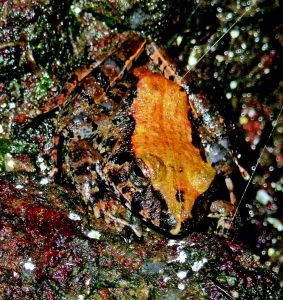
Crepuscular activity usually begins at around 5 PM, but its demarcation with the nocturnal period is sketchy and ambiguous, with animals active at dusk being also active at night. Thus, the best time to start looking for night-active animals is during the early evening hours, for a chance to see what isn’t seen during the day.
Scaly Specimen
On this trip, which took place at a section of the Sierra Madre in the province of Laguna, my companions and I started searching for some wildlife a little past 5 PM, when nocturnal spiders were just beginning to come out and build webs or, in the case of the non-web building types, forage. While walking along the main trail, a juvenile monitor lizard (Varanus marmoratus), about two feet in total length, scampered into the undergrowth and into a ledge.
First Frog Sighting in Sierra
On a waterfall, one of us found a frog from the genus Platymantis, with an orange dorsum clearly set off from the cryptically colored lateral sides and legs. Had this one been sitting on leaf litter instead of on a rock, we would have missed it.
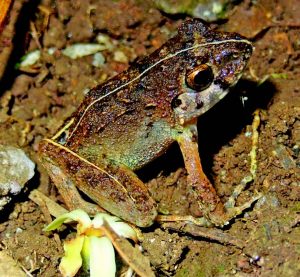
But this was where it got interesting: I did a mental note and felt strongly that this specimen was conspecific with a color variant of the so-called Platymantis sp. 3 “See-yok”, which was found originally in Kalinga and since discovered on many sites in both northern and central Luzon. If my hunch was correct, then this was the first specimen of this frog to be found on southern Luzon, as supported by a 2013 report by Rafe M. Brown and colleagues published in ZooKeys.
Denizens of the Dark
On the same waterfall, we found what we thought was a snake, only to prove itself as a sphinx moth larva. The ruse was particularly effective for birds, who would fly away instantly as soon as these larvae reared to show the eyespots.
Along the trail, we found a large monarch gecko (Gekko monarchus) with calcium deposits on both sides of the neck. These geckoes were common here, and in a forested area in my own place, these lizards displayed no fear to humans and could be photographed at close range without any risk of them fleeing.
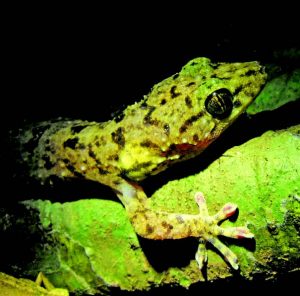
Further on, I found a large specimen of the giant Otosaurus cumingii, the largest among Philippine skinks. I have seen many examples of this skink from other trips, but this one was by far the most impressive due to its size and the rich coloration: I supposed that the lizard was about 12 or 13 inches in total length. It backed off and hid in a rock, but not before we had snapped a few worthwhile photos.
On the ground among fallen leaves, we found examples of the very common forest frog Platymantis dorsalis, with one being a rather uncommon striped form. And on a tree stump that had gathered soil eroded from above it, I noticed the telltale web of a tarantula. When I did manage to coax it out, it proved to Phlogiellus bundokalbo, a small species known from the mountains within the Sierra Madre. This was a very cryptic species that constructed multiple entrance and exit holes, giving the impression that there were several spiders occupying a small area, when in fact the holes were all made by a single individual.
Patient Predators
On embankments, there were several slit-like burrows and, upon close examination, pincers could be seen poking out, waiting for prey to come by. These burrows were made by Liocheles waigiensis, a scorpion with very long pincers relative to body length and thin, weak tails. The population appeared stable due to the number of burrows and individuals observed, and poachers hopefully would not discover the area if it were to stay this way.
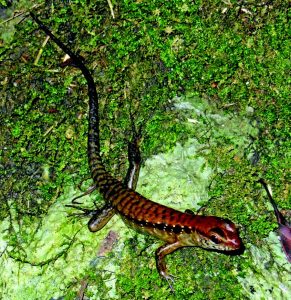
Another arachnid predator lurked in the same habitat, a Charon grayi. Specimens of this tailless whipscorpion roved actively in the dark in search of prey, which they would detect using the whip-like extensions of their second pair of legs. Despite their fearful appearance, these animals were rather delicate and incapable of defending themselves. Vinegaroons (Thelyphonus sp.) were more cryptic and preferred to hunt at ground level; true to form, they would spray acetic acid to deter would-be predators if they could not withdraw back into their burrows in time.
Giant huntsmen (Heteropoda sp.) and other sparassids patrolled the open grounds.
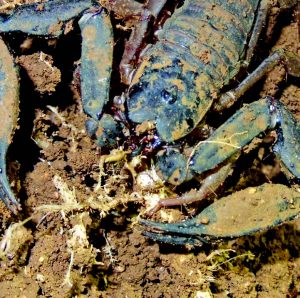
If anything, the remarkable diversity and individual numbers of predatory arthropods could probably be attributed to crickets that were so ubiquitous that predators would not have a difficult time catching some. Assassin bugs and house centipedes (Scutigera sp.) completed the line-up of impressive predatory arthropods in the area.

Further up, we witnessed a turf war between what looked like Oecophylla smaragdina (the popularly known ‘hantik’) and black termites, with a piece of twig serving as boundaries of each one’s territory.
This appeared in Animal Scene magazine’s October 2018 issue.






